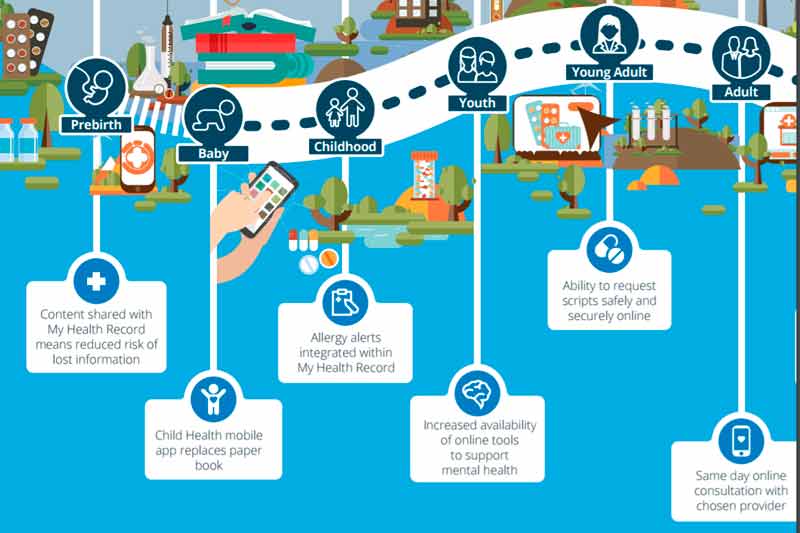
Image from National Digital Health strategy, Safe, seamless and secure: evolving health and care to meet the needs of modern Australia
The Council of Australian Governments (COAG) Health Council approved Australia’s National Digital Health strategy (2018-2022) on August 4, to support the uptake of digital health services.
The strategy titled 'Safe, seamless, and secure: evolving health and care to meet the needs of modern Australia' identifies seven key priorities for digital health in Australia: 1) Health information that is available whenever and wherever it is needed; 2) Health information that can be exchanged securely; 3) High-quality data with a commonly understood meaning that can be used with confidence; 4) Better availability and access to prescriptions and medicines information; 5) Digitally-enabled models of care that drive improved accessibility, quality, safety and efficiency; 6) A workforce confidently using digital health technologies to deliver health and care; and 7) . A thriving digital health industry delivering world-class innovation.
The delivery of a My Health Record for every Australian by 2018, unless they choose not to have one, will underpin several of these priorities. For the roll-out of My Health Record, the Australian government allocated AU$374.2 million in its 2017/2018 Budget, over a period of two years from 2017-18 onwards, including AU$94.0 million in capital.
More than 5 million Australians already have a My Health Record, which provides potentially lifesaving access to clinical reports of medications, allergies, laboratory tests, and chronic conditions. Patients and consumers can access their My Health Record at any time online or on their mobile phone.
The strategy will also enable paper-free secure messaging for all clinicians and will set new standards to allow real-time sharing of patient information between hospitals and other care professionals.
In June, the ADHA released a Request for Tender (RFT) to develop a Strategic Interoperability Framework for Australia, to enable better and seamless sharing of information. In July, ADHA revealed that it is working together with clinical information systems vendors to develop nationally scalable secure electronic messaging between healthcare providers. The technology would enable the secure flow of health data from one healthcare provider to another, irrespective of the software they are using, the organisation they work for, or with whom they are communicating.
The strategy will prioritise development of new digital services to support newborn children, the elderly, and people living with chronic disease. It will also support wider use of telehealth to improve access to services, especially in remote and rural Australia and set standards for better information sharing in medical emergencies – between the ambulance, the hospital, and the GP.

The strategy was developed by all the governments of Australia in close partnership with patients, carers and the clinical professionals who serve them, together with leaders in industry and science.
It draws on evidence of clinical and economic benefit from many sources within Australia and overseas, and emphasises the priority of patient confidentiality as new digital services are implemented. The Australia Digital Health Agency (ADHA) has established a Cyber Security Centre to ensure data security. More than 3,000 people participated in the consultation on the National Digital Health Strategy between October 2016 and January 2017. Public meetings were held in more than 103 locations across Australia. More than 1,000 formal submissions and survey responses were received.
The ADHA, which is responsible for co-ordinating implementation of the strategy, will now be consulting with partners across the community to develop a Framework for Action. The framework will be published later this year and will detail implementation plans for the strategy.
In a communique issued after their council meeting in Brisbane, the Health Ministers noted: “The strategy has identified the priority areas that form the basis of Australia’s vision for digital health. It will build on Australia’s existing leadership in digital health care and support consumers and clinicians to put the consumer at the centre of their health care and provide choice, control, and transparency.”
Australian Digital Health Agency (ADHA) CEO, Tim Kelsey, said, “Australians are right to be proud of their health services – they are among the best, most accessible, and efficient in the world. Today we face new health challenges and rapidly rising demand for services. It is imperative that we work together to harness the power of technology and foster innovation to support high quality, sustainable health and care for all, today and into the future.”
The strategy was welcomed by the Australian Medical Association (AMA), Royal Australian College of General Practitioners (RACGP), Pharmacy Guild of Australia, Pharmaceutical Society of Australia (PSA), Medical Software Industry Association (MSIA), Consumers Health Forum (CHF) and the Health Informatics Society of Australia (HISA).
ADHA is working closely with all these stakeholders to maximise the benefits that My Health Record can achieve for patient care.
For instance, on August 9, ADHA announced that six additional community pharmacy software vendors have agreed to connect up to the My Health Record system, which will make it easier for pharmacists to securely access patient care information. Negotiations are ongoing with a number of other pharmacy dispensing software vendors, and the ADHA expressed confidence that agreements will be in place with almost all vendors in the next few months. In July, a partnership was initiated with the Pharmacy Guild of Australia.
In July, ADHA also announced that it has initiated a 2-year
pilot for the use of My Health Record in hospital emergency departments, in partnership with the Australian Commission on Safety and Quality in Health Care (ACSQHC).
Read the National Digital Health Strategy document here.
















